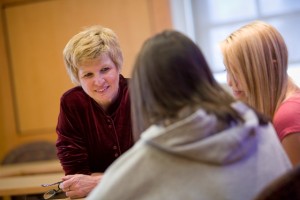
Professor Margarete Lamb-Faffelberger teaches a class in the Max Kade Center.
Students at Lafayette have access to a beautiful and high-tech resource center where they can study and enhance their understanding and appreciation of German language and culture.
The Max Kade Center for German Studies is a classroom, reading room, conference room, informal discussion area, multimedia presentation facility, and library. It serves as the hub of German activity and learning at the College, a place where students can work on class projects and conduct research for independent study, honors, and EXCEL projects.
Located on the fourth floor of Pardee Hall, the center was founded in 2002 with a large grant from the Max Kade Foundation, which has continuously funded the center and its activities since its inception. Its mission is to advance German-American relations and promote mutual appreciation through the collaboration of teachers, scholars, and artists.
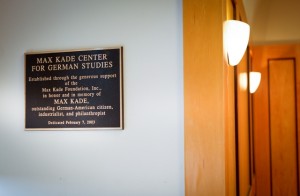 “The Max Kade Center for German Studies contributes significantly to interdisciplinary teaching and learning at Lafayette College. It also plays an important role in the internationalization of the campus and in Lafayette’s drive to provide a global education,” says the center’s director, Margarete Lamb-Faffelberger, professor of foreign languages and literatures.
“The Max Kade Center for German Studies contributes significantly to interdisciplinary teaching and learning at Lafayette College. It also plays an important role in the internationalization of the campus and in Lafayette’s drive to provide a global education,” says the center’s director, Margarete Lamb-Faffelberger, professor of foreign languages and literatures.
Students appreciate the room’s functionality and versatility.
“I have been in the Max Kade Center for all of the German classes that I’ve taken at Lafayette,” says Meagan Betke ’13 (Commack, N.Y.). “Not only is it a gorgeous classroom, it is also equipped with plenty of whiteboard and chalkboard space for notes, as well as a computer and projector that we can use to watch relevant YouTube videos, research pictures of German architecture, and view PowerPoint presentations. All of these aspects create an atmosphere conducive to learning German and building relationships with other German students.”
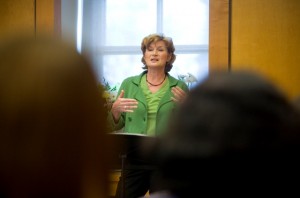
2008 Max Kade writer-in-residence Zdenka Becker
In addition to being a physical resource space, the Max Kade Center brings scholars to campus and organizes conferences, exhibits, and other events to further appreciation of German studies.
Each year, the center hosts either a writer-in-residence or a guest professor. This fall, Hans-Michael Speier, a writer and academic from Freie Universität Berlin, will be a writer-in-residence. He will co-teach a literature seminar with Lamb-Faffelberger, as did German writer Zafer Senocak in 2005, Austrian writer Zdenka Becker in 2008, and Austrian author Gabriele Petricek during the fall 2010 semester. Petricek also worked with students in advanced German classes and gave a performance of her stories and poetry.
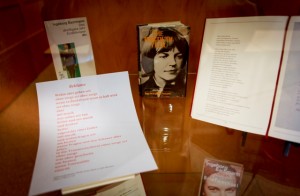
Writing Against War exhibit featuring Austrian poet and author Ingeborg Bachmann
“I really enjoyed that experience because they turned the Max Kade room into a theater of sorts,” says Susan Grunewald ’11 (Wilton, Conn.), a Russian and East European studies major. “One of the coolest parts was when Frau Petricek performed one of the actions of a character in her story. The man in the story either wrote backwards or upside down and Frau Petricek was able to do that. She wrote in this fashion on a sheet of notebook paper under a special overhead projector that was then put up on the giant computer screen in the room. It was fascinating to see her do that.”
Last fall, the center presented the exhibit Writing Against War featuring Ingeborg Bachmann, a 20th century Austrian poet and author. The exhibit traveled through Europe and the United States before coming to Lafayette.
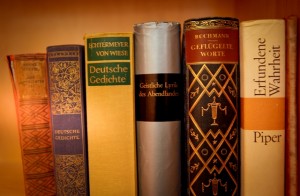 “The exhibit was amazing because Ingeborg Bachmann was one of the most influential writers after World War II in Germany. This exhibit focused on writing against war, which enumerated on the theme of this year’s [first-year student summer orientation theme]: ‘Waging War; Staging Peace,’ and therefore greatly aided in my understanding of this topic,” says Tia Seibold ’14 (Sisters, Ore.), a German major.
“The exhibit was amazing because Ingeborg Bachmann was one of the most influential writers after World War II in Germany. This exhibit focused on writing against war, which enumerated on the theme of this year’s [first-year student summer orientation theme]: ‘Waging War; Staging Peace,’ and therefore greatly aided in my understanding of this topic,” says Tia Seibold ’14 (Sisters, Ore.), a German major.
This spring, the center will cosponsor a conference on undergraduate research. Lamb-Faffelberger is organizing the event along with two Moravian College professors. Nineteen students from eight institutions will present their work at the conference, which will take place at Moravian College March 26.
In October, the center will cosponsor a conference at Lafayette on artwork looted by Nazis during World War II. Diane Ahl, Rothkopf Professor of Art History, and Rado Pribic, Edwin Oliver Williams Professor of Foreign Languages and Literatures, are organizing the event.
The Max Kade Foundation was established in 1944 by Max Kade, an emigrant from Germany to New York City who became successful in the pharmaceutical industry. Kade was committed to advancing German-American relations. The foundation promotes the mutual understanding of the people and cultures of Germany and the United States. The foundation has funded research facilities, libraries, dormitories, meeting places, and German and German-American studies programs.
The study of German has been an important part of Lafayette’s curriculum since its founding. Lafayette’s three German instructors teach an average of 50 students each semester. Fifteen to 20 percent of Lafayette students enrolled in German also major in it, and many more declare German as their minor.




